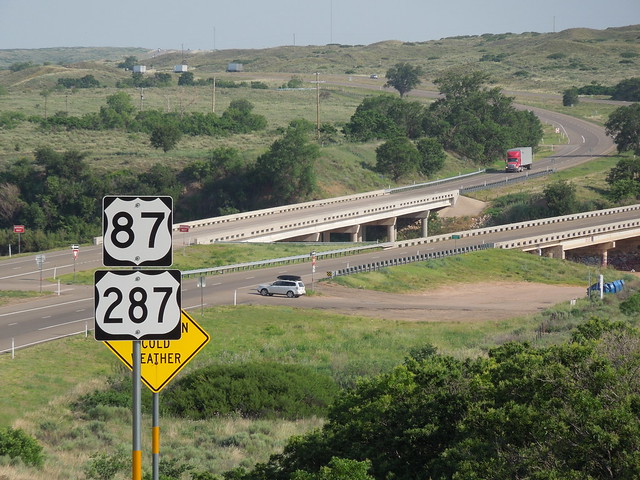|
Historically US 80 connected Dallas and Ft. Worth. Although US 80 was decommissioned along that segment in 1993, some evidence of US 80's historical presence in Ft. Worth survived for nearly another three decades. This photo was taken looking north on Beach Street:
0 Comments
US 87 and US 287 converge in Dumas, Texas, and share about 49 miles of pavement down to Amarillo, where the two routes separate again.
(Most recently updated 4/5/2022)
One of San Angelo's marketing slogans is "The Oasis of West Texas". This is not hyperbole; most approaches to the city are somewhat stark, so in contrast upon arrival in Angelo, one may well be pleasantly surprised at all of the rivers, reservoirs, trees and other vegetation:
One of the city's other monikers is "The Pearl of the Conchos", which has a double meaning, referring to the freshwater Concho pearls that were historically harvested from area waterways. The three branches of the Concho River all converge in San Angelo; that was illustrated on this other slogan from days gone by:
When the US highway system was inaugurated in late 1926, the only US route to initially serve San Angelo was US 385 (that is, the original US 385, not the current US 385). The new designation was added to Texas State Highway 9:
From humble beginnings to great lengths
(last updated 11/27/2023)
In 1925, when the US highway system was envisioned, there were plenty of proposed east-west routes crossing the Great Plains states, but there was a conspicuous lack of north-south routes between US 81 and US 85. This gap was about 300 miles wide in North Dakota, and it only increased to the south, until the gap was more like 500 miles wide in Texas. Obviously this was not an ideal situation for those six states, but a big obstacle prevented an easy remedy: there were very few decent-quality, long-distance, north-south roads through the Plains. One exception was the road between the capital cities of the two Dakotas. Those states petitioned AASHO for the US 83 designation, and by the time the US route system was officially inaugurated in 1926, their wish had been granted. For the next couple years, US 83 was a very short route -- only about 170 miles long -- running between Bismarck ND and Pierre SD:
However, by the early 1930s the US 83 designation had been extended not only north to the Canada border, but all the way down to the Mexico border too. This increased US 83's distance to nearly 1900 miles, and made it one of the longest north-south US routes. Additionally, as a result of US 83's new role as a trunk route, three newer US routes were numbered as branches of US 83. Two of these soon became quite lengthy themselves, and they still exist (US 183 and US 283). Just as these highways intertwine with each other, their history is also interrelated. This article examines the evolution of US 83, as well as the x83 routes that are part of its "family".
(last updated 3/7/2022)
Many Route 66 tourists simply enjoy the romance and the lore of the fabled road. The facts aren't all that important, and if one of the legends turns out to be a tall-tale, they'd rather not know about it. And that's fine -- if you're one of those people, I say you gotta do you -- get out there and enjoy the Mother Road.
...then you might want to stop reading here, because this page contains research that discredits some of the "conventional wisdom" about US 66 that is found elsewhere. On the other hand, if you're interested in facts and details, then please carry on.
In 1975 TX and NM asked AASHTO to assign a new US highway designation between Dallas and Elida NM; following is the route description from the actual minutes of the meeting:
(last updated 9/29/2022)
When the US highway numbers were assigned in 1927, US 81 was the only route initially serving Waco. But US 77 soon joined with it, when it was extended down from Dallas in 1933. These routes were concurrent south of Hillsboro, and through Waco they followed New Dallas Highway, Hillsboro Drive, Elm Street, Washington Street, 18th Street, and Circle Road, to the Circle. From there they diverged, with US 77 following Robinson Road, and US 81 following the corridor now occupied by I-35.
US 84 was extended through Texas in 1934, and it came into Waco on Bellmead Drive, which became Elm Street further west. At the junction with Hillsboro Drive, US 84 joined US 77-81 along Elm, Washington, and 18th. At Franklin Avenue, US 84 diverged and followed that out of town via Woodway Drive. The photo below was taken during that timeframe:
That was on US 77-81-84, looking northeast on Elm. At this junction US 84 continued straight ahead on Elm (becoming Bellmead Dr), while US 77-81 traffic split off to the left on Hillsboro (becoming New Dallas Hwy).
(Most recently updated 4/28/2024)
At 568 miles*, Texas 16 is the longest state highway in Texas (that is, the longest road with a state highway designation, as opposed to a US route or an interstate). The second-longest is Texas 6, at 551 miles*. These two routes intersect in the town of De Leon. Actually, they overlap for about a half-mile:
(most recently updated 1/26/2024)
US 96 is one of the worst numbering violations in the US route system, because it is wrong on several levels:
At the time, the south terminus of US 59 was in Port Arthur, and the diagonal highway between Houston and Laredo was designated US 96:
(last updated 6/22/2023)
The geo-center of Texas is roughly between Brownwood and Brady; the nearest locale is the minuscule burg of Mercury. Today US 377 is the closest major highway passing near the point, and a roadside historical marker is posted just south of Mercury: |
AuthorCategories
All
Archives
July 2024
|












 RSS Feed
RSS Feed
